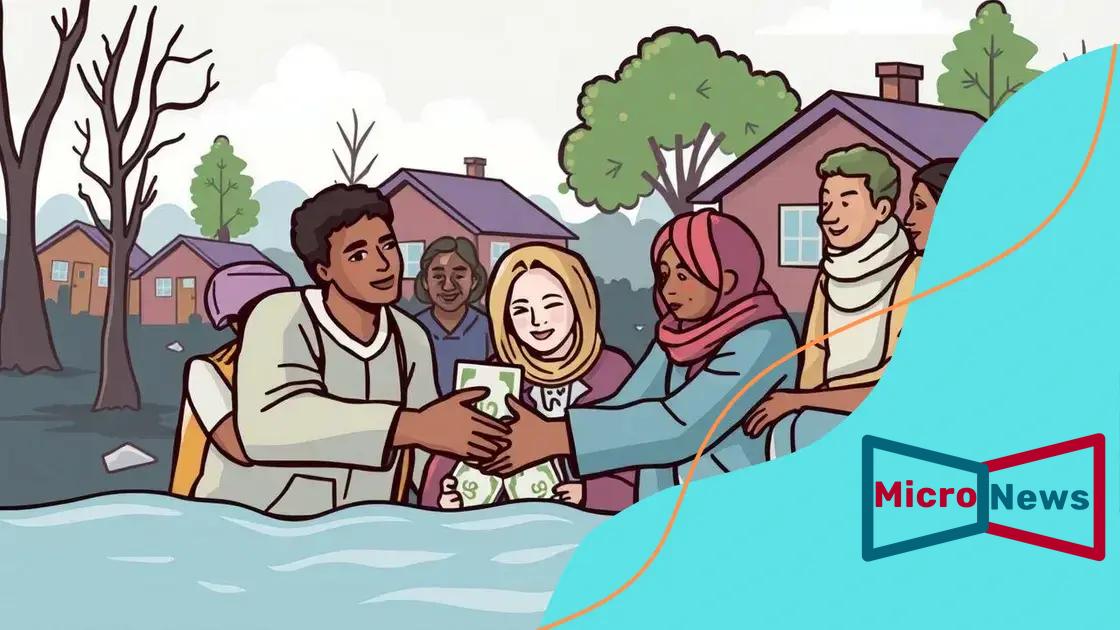Emergency financial aid programs for disaster relief

Emergency financial aid programs provide critical support to individuals and families affected by disasters, helping them recover through immediate financial assistance and resources.
Emergency financial aid programs for disaster relief can be a lifesaver during tough times. Have you ever thought about how these programs truly work and who can benefit from them? Let’s dive in!
Understanding emergency financial aid programs
Understanding emergency financial aid programs is essential for those affected by disasters. These programs can provide immediate relief and support when disasters strike. They help individuals and families recover from unforeseen circumstances by offering various types of financial assistance.
Types of Emergency Financial Aid Programs
Different programs exist to aid affected communities. Some are government-funded, while others come from nonprofit organizations. Each program has unique eligibility requirements and application processes.
- Federal disaster relief funds
- State-specific assistance programs
- Nonprofit organization grants
- Community-based funding
Additionally, understanding the application process is vital. Often, applicants need to provide documentation related to the disaster’s impact on their lives. This can include income statements, proof of property loss, and identification. Being prepared with the necessary information can streamline the application process.
Eligibility Criteria
Eligibility for these programs typically depends on several factors. Each program has its own set of requirements, which may include income level, residency, and the extent of the disaster’s impact. Many programs also prioritize applicants with the greatest need, ensuring that those who are most affected receive the help they require.
In some cases, emergency financial aid can also cover various expenses beyond immediate needs. This includes housing assistance, medical expenses, and even funding for repairs. Programs like these are crucial for rebuilding lives and restoring communities after a disaster.
The path to understanding emergency financial aid begins with research. It’s important to explore all available resources thoroughly. Knowing where to start and what to expect can significantly impact recovery efforts.
Types of disaster relief funds
When looking into types of disaster relief funds, it’s crucial to understand the different sources available for assistance. These funds can significantly help individuals and communities recover effectively. There are various options to explore when disaster strikes.
Federal Disaster Assistance
The federal government offers numerous programs that provide aid in the aftermath of disasters. These funds are often distributed through agencies like FEMA (Federal Emergency Management Agency). They help with essential needs, temporary housing, and property repairs.
- Individual Assistance Program
- Public Assistance Program
- Hazard Mitigation Grant Program
Each of these programs targets specific areas of disaster recovery. For instance, the Individual Assistance Program helps individuals directly, while the Public Assistance Program focuses on restoring community infrastructure.
State and Local Programs
State and local governments also have their own disaster relief funds. These might include initiatives for low-income households or specific recovery programs tailored to unique community needs. Many states have emergency funds set aside to assist residents promptly.
Nonprofits and charitable organizations play a vital role in disaster relief funding. These entities often collect donations to provide immediate support to affected individuals and families.
- Local food banks
- Disaster relief funds from churches
- Community foundations
These funds are usually designed for quick responses, providing essentials like food, clothing, and temporary housing to those in need.
Understanding these varied types of disaster relief funds can facilitate quicker access to aid, which is essential during times of crisis. Each source has distinct eligibility requirements and application processes, so staying informed can lead to faster recovery.
How to apply for assistance effectively

Applying for assistance effectively can make a significant difference in getting the help you need during tough times. Understanding the process is the first step. Knowing how to present your case clearly can increase your chances of success.
Gather Necessary Documentation
Before starting your application, it’s important to gather all necessary documents. This might include proof of income, identification, and any paperwork related to the disaster. Having everything in order will streamline your application.
- Income statements
- Identification documents
- Proof of property damage
- Any previous assistance received
These documents serve as evidence of your need for assistance and are often required by funding agencies.
Follow Application Instructions Carefully
Each assistance program may have different application instructions. Carefully read and follow these guidelines. Filling out forms accurately and completely will help prevent delays.
Make sure to check deadlines, as many programs have specific timelines for applications. Submitting your application early can also be beneficial, especially if funds are limited. You want to ensure your application gets the attention it deserves.
Be Honest and Clear
When describing your situation, be honest and clear. Providing detailed information can help reviewers understand your needs. If you are unsure about something, reach out to program representatives for clarification.
Sometimes, seeking help from local organizations can also assist with the application process. They may offer guidance, support, or even workshops to walk you through the steps.
Staying organized and proactive during the application process is critical. Keep track of any correspondence you have with the assistance program. This can be helpful if you need to follow up on your application or provide additional information.
Success stories of financial aid in action
Success stories of financial aid in action showcase the powerful impact these programs can have on individuals and communities. Hearing about real-life examples can inspire hope and provide insights into how aid can change lives.
Case Study: The Johnson Family
After a tornado devastated their neighborhood, the Johnson family faced significant challenges. Thanks to a local disaster relief fund, they received immediate financial assistance to cover temporary housing costs. This support enabled them to find a new home while working on repairs to their damaged property.
- Financial aid covered moving expenses.
- The family received grants for home repairs.
- Local organizations provided food and essentials.
The Johnsons are now thriving, highlighting how prompt financial aid can facilitate recovery and rebuilding.
Community Recovery in Action
Numerous communities have come together to support each other during tough times. Various local funds funded rebuilding efforts after flooding. One significant initiative mobilized volunteers to assist families in rebuilding their homes. This outreach was made possible through a combination of funds and community spirit.
The project included:
- Restoration of community centers.
- Clean-up efforts conducted by local volunteers.
- Support groups to help residents share their experiences.
As a result, the town has made a remarkable recovery, illustrating how coordinated support can lead to stunning transformations.
These success stories demonstrate that when financial aid and community efforts align, people can rebuild their lives and regain hope. Knowing these stories can motivate others to seek help when they need it most.
Challenges in accessing emergency funds
Accessing emergency funds can often come with several challenges. Understanding these hurdles is important for those seeking assistance. Many individuals face obstacles that can delay or prevent them from receiving the help they need.
Complex Application Processes
One significant challenge is the complexity of the application process. Many relief programs have specific requirements and documentation that must be submitted. This can be confusing and overwhelming, especially for those who are already dealing with the stress of a disaster.
- Complicated forms can lead to errors.
- Not all applicants understand the required documentation.
- Deadlines add pressure during a stressful time.
This complexity can result in delays or even rejections, causing frustration among applicants.
Eligibility Requirements
Another challenge is meeting the eligibility requirements for various programs. Many assistance funds have strict criteria that applicants must fulfill. For some, these criteria may include income limits, residency status, or proof of disaster impact.
Understanding these requirements can be daunting. Often, individuals may not know they qualify for a program until they start the process. This lack of information can lead to missed opportunities for much-needed support.
Limited Awareness and Outreach
Moreover, limited awareness of available resources adds another layer of difficulty. Many individuals may not know what assistance is available to them or how to access it. Outreach efforts are essential to inform communities about their options.
- Local organizations often lack funding for outreach.
- Some communities are underserved and may not receive information.
- Language barriers can prevent some individuals from accessing aid.
Improving awareness is crucial for helping those in need connect with potentially life-changing financial support.
In conclusion, while accessing emergency financial aid can be challenging, it is crucial for those impacted by disasters. Understanding the application process, eligibility requirements, and available resources can significantly improve your chances of receiving assistance. Success stories demonstrate the positive impact financial aid can have on individuals and communities. By raising awareness and addressing barriers, we can ensure that help reaches those who need it most. Together, we can make a difference in times of crisis.
FAQ – Frequently Asked Questions about Emergency Financial Aid Programs
What are emergency financial aid programs?
These programs provide immediate financial assistance to individuals and families affected by disasters, helping them with recovery and basic needs.
How can I apply for financial aid effectively?
To apply effectively, gather all necessary documentation, follow application instructions carefully, and ensure you meet the eligibility requirements.
What challenges might I face when accessing these funds?
Common challenges include complex application processes, strict eligibility requirements, and limited awareness of available resources.
Are there any success stories from financial aid programs?
Yes, many individuals and communities have successfully rebuilt their lives thanks to financial aid, showcasing the positive impact these programs can have.





